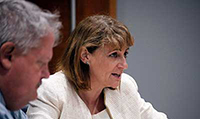This week, International Women’s Day was celebrated across the globe.
This year’s campaign theme was #PressForProgress in reaction to the World Economic Forum’s 2017 Gender Gap Report Findings telling us that gender parity is over 200 years away!
The campaign is not country, group or organisation specific and is a time to reflect on ways you can #PressForProgress in your own country, state, workplace or organisation.
Here’s an overview of female representation and gender parity in Queensland:
- In Queensland, the gender pay gap is currently 18.3 percent*
- (Australia wide the full-time gender pay gap is 15.3%)
- This results in not just lower earnings but subsequently lower savings and superannuation.
- Queensland women account for 64.9% of public housing tenants and 74.1% of public Aboriginal and Torres Strait Islander housing tenants
- Women represent 18.9 % of Queensland chief executives and managing directors
The gender pay gap is influenced by a number of factors including:
- Discrimination and bias in hiring and pay decisions
- Women and men working in different industries and jobs with female-dominated industries and jobs attracting lower wages
- Women’s disproportionate share of unpaid caring and domestic work
- Lack of workplace flexibility to accommodate caring and other responsibilities, especially in senior roles
- Women’s greater time out of the workforce impacting career progression and opportunities
The female pioneers who led the way in Queensland local government
Whilst we have a lot of work to do before the gender pay gap is closed in Australia and Queensland we can take heart in the women who have stood up and led Queensland in local government. Here’s a few of the inspirational women who served their communities across Queensland.
Dr Ellen Mary Kent Hughes

Born in Melbourne in 1893, Ellen graduated as a medical doctor in 1917. Marrying in July that year, Ellen was widowed just three months later and later bore a son. Mary Ellen became the first woman ever elected to a Queensland council when she was elected to Kingaroy Shire Council.

Mary Hyacinthe Petronel White
Born in Townsville in 1900, Mary trained as a stenographer and worked in Sydney before moving back to Brisbane where, in 1949, endorsed as a candidate for the non-political group the Citizen's Municipal Organisation, she became the first women elected to represent an Australian capital city council. She served for 18 years as an alderman representing Hamilton (Clayfield) ward. A strong advocate for women's interests, Mary used her position on council to push for better public facilities and improved legal protection for women. Mary retired in 1967 and appointed OBE later that year for her services to local government.
Blanche Amelia Smith

Blanche Amelia Smith was born in Caboolture in 1883. After serving with her father, who was the postmaster at Nebo, Blanche was appointed Shire Clerk of the Nebo Shire Council in 1908, becoming the first female shire clerk in Queensland. She married Shire Councillor, Nathaniel Perry, that same year and held the post of Shire Clerk until resigning the position in 1917.

Nell E Robinson
Eleanor (Nell) Elizabeth Robinson was born in Toowoomba in 1915. She travelled to Britain in the 1930s, where she enrolled a the Royal Academy of Dramatic Art and returned to Toowoomba before completing the course when her mother became ill, at the outbreak of WWII. Nell was elected as an alderman to Toowoomba City Council in 1961 and elected Mayor in 1967, becoming Queensland's first female Mayor, retiring in 1981 due to ill-health.

You can read more about women across Queensland who are leading the way in local government :Generation Next: Women leading their local communities.
How you can #PressForProgress
- Visit the International Women's Day website and take the pledge to press for gender parity progress
- Use the myriad of resources like the video below and share across your social media using the hashtag #PressforProgress
- Get involved with the ABC Landline campaign currently inviting all women of the land and waters to share photos of a 'day in the life' of farming/agriculture and food and fibre production in Australia - follow Landline and the Invisible Farmer Project on Facebook and add a photo of youself - a 'day in the life' photo showing what you are doing today.